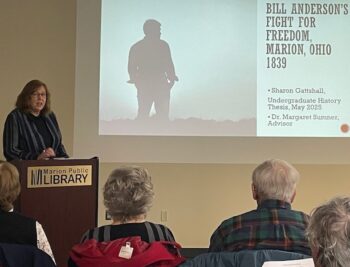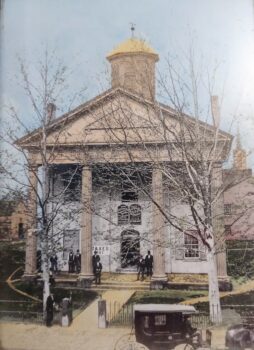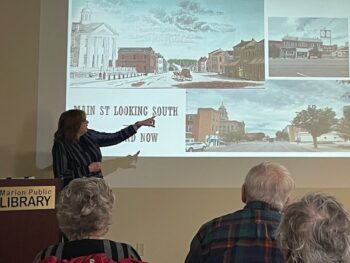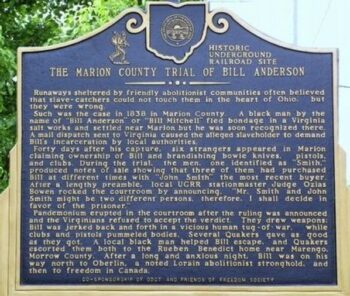One man’s trial and the riot it sparked put Marion in the national spotlight in 1839. Local historian Sharon Gattshall spent three years researching the life of Bill Anderson, whose trial on accusations of being a fugitive slave threw the city into turmoil and ignited national debate.
“Many think the civil rights movement began in the 1950s, but I believe what happened in Marion was part of it and many historians agree,” Gattshall said at a presentation at the Marion Public Library.

Bill Anderson’s Start in the South
Born into slavery around 1806, Anderson labored under brutal conditions in the Kanawha salt works in Virginia.
“[Anderson] prayed to the Lord…’As strong as a yoke of oxen can pull to free me from my cruel master’,” Anderson recalled in Aaron Benedict’s History of Peru Township, Morrow County, Ohio.
New Life in Marion
Anderson escaped to Zanesville and then moved to Marion in 1838. He was a skilled laborer, butcher, barber and horse handler. The talented musician was described as lively, industrious and popular.
“Bill Anderson was the hero…people liked him. That’s why Marion came to his aid,” Gattshall said.
In 1839, the village of Marion had just 570 residents. County residents included 52 free Black people and a Quaker community active in the Underground Railroad.

Black Laws and Fugitive Slaves
Although Ohio was a free state, Black Laws required Black residents to present a certificate of freedom, pay fees, and secure a $500 bond from two white landowners. Those helping or employing runaway slaves faced huge fines, with half the money going to the informant.
A group of Virginian slave catchers and a man claiming to be one of Anderson’s former owners came to Marion and had Anderson arrested. Ohio’s Black Laws prohibited Anderson from testifying in his own defense.
Hundreds Attend Trial

The Marion Visitor Newspaper described the courthouse as overflowing for the hearing on Aug. 26, 1839. Nearly half of the village returned for the verdict on Aug. 27. When Judge Ozias Bowen ruled the Virginians hadn’t proven their case and declared the prisoner was free, a riot broke out.
A Black friend and a group of Quakers surround Anderson to escort him to safety. The Virginians, armed with pistols, bowie knives and daggers, grabbed Anderson and dragged him across the street to the office of John Bartram, a Justice of the Peace with pro-slavery leanings, to secure a different verdict.
Mob Throws Rocks and Fists

The crowd of nearly 200 people erupted. Angry residents on both sides of the verdict grabbed stones and lobbed them at the Virginians and the abolitionists. The mob ignored the sheriff and the judges calling for order. Fights filled Main Street. Someone broke open the armory and grabbed weapons. One attacked Justice Bartram, nearly stabbing him with a bayonet, according to the 1883 History of Marion County.
Race for Freedom
Judge Thomas Jefferson Anderson, an associate justice in the trial, forced open the back door of Bartram’s office to free the prisoner.
Bill sprinted away with the Virginians in hot pursuit. One caught up to Anderson and threatened to shoot him. Allies tackled the armed man and kept toppling pursuers until Anderson escaped. Anderson later sent word that he arrived in Canada via the Underground Railroad.
Riot Reverberates Across the Nation
The sheriff arrested rioters and the Virginians. The Marion Visitor’s report of the event was carried in newspapers across 14 states. (See bottom photo for the full article.)
“Few single events in Ohio have done more to crystallize sentiment not only in Ohio but throughout the nation,” The Marion Star reported.

Civil Rights Issue Divides Marion
Residents organized pro-slavery and abolitionist public meetings. Some were outraged by the Virginians’ defiance of the court ruling. Judges Bowen and Anderson survived attempts to disbar them.
One citizen described Marion’s response as “intense; relations, political, social and religious, were strained; men long friends hardly spoke to each other and this estrangement continued for years,” according to Gattshall’s research.
Local Interest Finds Anderson Relevant to Today
Dozens of people turned out at a number of Gattshall’s talks, including adult lifelong learning (ALL) classes at the Marion Public Library.
“This was very interesting…. Regardless of your political views, it’s exactly what’s happening now,” said Carol Crum, a retired Marion farmer.

For more info:
Sharon shares her research on the Marion Ohio 1839 – Bill Anderson’s Escape from Slavery Facebook page.
Sharon can be reached at osumsharon@gmail.com.
Related Articles:
Runaway Slaves Escaped to Freedom through Local Underground Railroad Stops | MarionMade
Ozias Bowen Homes | MarionMade
Highlighting Marion’s Legacy of Black Leadership | MarionMade
Memorial to Marion Soldiers, Sailors and Public Servants at Marion Cemetery | MarionMade
Marion in the Civil War | MarionMade
MarionMade! is a program of Marion Technical College.


















